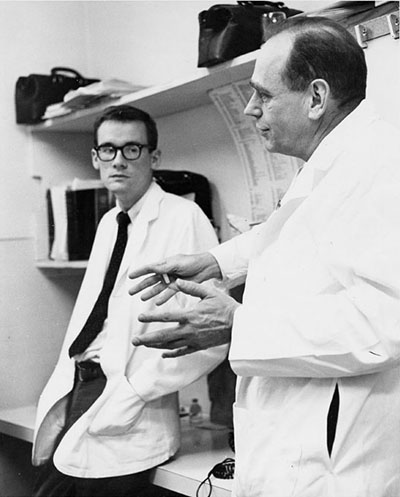
In the mid 1960s, Duke was involved with IBM, in a research project known as the Clinical Decision Support System. From this time on, Duke University Medical Center has not only been involved in research in the field of Biomedical Informatics, but has demonstrated strong commitment to medical computing projects.
One area of research grew out of the myocardial infarction research unit (MIRU) grant projects of the late 1960s. A group within the Division of Cardiology developed a research database for individuals seen at Duke Medical Center having a diagnosis of coronary artery disease. This research database, referred to as the living textbook of medicine, has been a leader in methods for extracting knowledge from computerized databases. The Duke Databank for Cardiovascular Diseases (DDCD) celebrated its 40th anniversary in September 2009. “When the databank was conceived in the ’60s, it was envisioned as a database specific to patients treated at Duke; in the ’70s, it grew in its ability to use statistical methods to analyze follow-up data. In the ’80s it rapidly expanded and diversified to include inter-institutional databases, and began to look more closely at the cost effectiveness of diagnostics and treatment strategies for cardiovascular disease. And in the ’90s, it spawned the creation of the Duke Clinical Research Institute, a multifaceted organization with a vast range of activities, including the conduct of large, multi-site clinical trials and outcomes research studies. The databank currently includes information on over 160,000 patients and the DCRI has entered over 500,000 people into clinical research studies.” The DDCD has produced well over 400 peer reviewed publications.
In the mid-1970s, a group of researchers at Duke developed the Duke Hospital Information System (DHIS). This system, marketed by IBM as PCS, is still one of the most implemented HISs in the world. DHIS provides patient registration, admission-discharge-transfer (ADT), order entry, laboratory results reporting, accounting and billing functionality at terminals located throughout the medical center campus.
Duke is also home of one of the first electronic medical records in the country, The Medical Record (TMR), lead by Dr. W. Ed Hammond and his team of students. Since TMR’s early days in 1968, on-going research into developing a computer-based medical record has driven the development of what became the premier computer-based medical record systems in the country. Originally developed for the ambulatory care setting, TMR expanded to the inpatient setting including Labor and Delivery Unit and the Surgical Intensive Care Unit at Duke (Hammond 2001). Later work included bridging the inpatient and outpatient domains into one continuous computerized patient record for the Bone Marrow Transplant Unit.
Over a decade ago, Duke researchers initiated use of an electronic medical record for behavioral health, the Clinical Management Research Information System (CRIS) (Gersing and Krishnan 2003). This system was the first electronic medical record designed to support both research and patient care. This system, known today as Holmusk, is in use in over 30 institutions.
Over the years, Duke has maintained a focus on bringing resources together for the benefit of researchers, clinicians and patients. Starting in 1987 with the initial IAIMS Pilot award 5G08LM004613 from the National Library of Medicine (NLM), the Duke Integrated Academic Information Management System (IAIMS) was initiated. The project culminated in implementations and demonstrations of full IAIMS function in each of four user domain (administration, education, patient care and research) as well as the extension of a critical mass of IAIMS functions to all users (Stead et al 1993).
The awarding in 1991 of NLM funding for an institutional training program spanning years 1992 – 2002 represents a high point of informatics education and research at Duke. Today, more than 40 years of experience are brought to bear in the training of new health informaticists and informatics researchers.